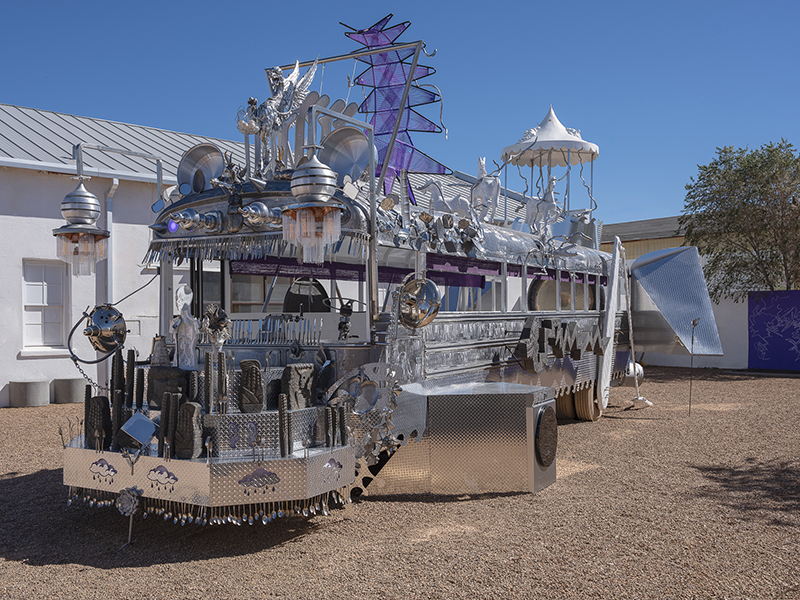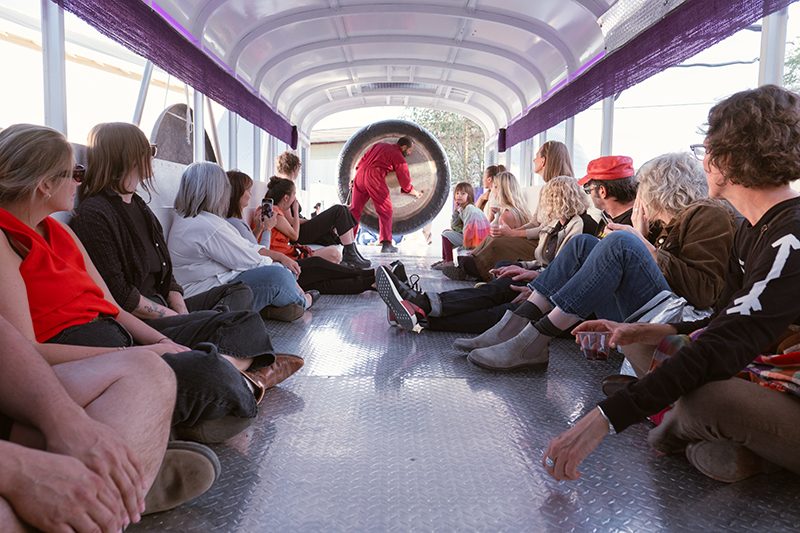
Commissioned by the Institute of Contemporary Art/Boston, Mariposa Relámpago is a former school bus, reconfigured and stripped to gleaming metal. It’s an homage to the customized buses common in El Salvador and much of Latin America, bedecked with dazzling ornamentation that are loaded with symbolism for the artist. There are stone carvings suggestive of Mayan artifacts. Tree roots that have been carved into snake-like shapes and dipped in chrome adorn the roof surfaces—a reference to the symbol of medicine. A sculpture of a child represents those who, like himself, attempted to make the treacherous journey to a new life. Flatware affixed to the windshield frame of the bus represents communal dinners. A basket of white onyx eggs—onyx is believed to repel negative energy—hangs from the mouth of a dragon on the roof. Grasshopper legs are mounted on the aft sides of the vehicle, symbolizing the jump that migration represents. Spinning clothes dryers in place of the front wheels suggest the movement of the bus.
In all, more than 600 found and commissioned objects are incorporated into this kinetic work of art. In contrast to the many objects on the bus exterior, the metal interior of the bus has been stripped of all seating and windows; viewers can sit or lie on the floor. The back of the bus has been modified to fully open to the outside. Several large gongs hang in and on the bus, the largest boasting a 60-inch diameter. Each is tuned to specific therapeutic frequencies representing water, earth, and other sound characters, and when struck, they resonate throughout the bus surfaces and surrounding landscape, creating a meditative healing environment for participants. “In some ways, the bus is like a Trojan Horse, sneaking unsuspecting observers into a therapy session,” says Maravilla.
The sculpture can be considered a third life for a former school bus originally from the United States. Buses that reach the end of their service life in the United States are often sold into service in Latin America and beyond. As conceived by Maravilla, such a bus sourced in El Salvador would endure a journey similar to his own. Blessed by shamans and anointed with volcanic ash, it was driven to Mexico City to be sculpturally transformed, but that bus would not complete the journey. As work progressed on the sculpture in Mexico City, Maravilla began preparing the paperwork to import it into the United States. To his chagrin, he discovered that the bus had been reported stolen from a church in El Salvador. A reflection of the migrant experience, no clean title for the bus meant an impossible bureaucratic hurdle for legal entry. There would be no coyote to smuggle a bus-sized sculpture across the border. An alternative bus with appropriate paperwork was purchased in Mexico City, and the work-in-progress bus was sold at a loss for spare parts. To retain the original mojo for the sculpture, the ceremony that blessed the original bus was repeated in El Salvador with symbolic proxies. These objects are included in the completed work.
The name for the work Mariposa Relámpago (“Lightning Butterfly”) is attributed to a conversation he overheard on the streets of Oaxaca. According to Maravilla, “I was in Oaxaca and had a dream about butterflies and lightning. The next day waiting at a crosswalk on the street, I overheard two elderly women discussing an ancient Mexican healer. The healer’s name was Mariposa Relámpago.” He took the name as prophecy with the reference to the healing intention of the sculpture.
Maravilla firmly believes in the healing powers of sound and other natural medicines. He attributes sound therapy in part to his own recovery from colon cancer—a disease he is convinced is a manifestation of the traumas living in war-torn El Salvador, his dangerous escape to the United States, and subsequent undocumented life wrought on his body. Now Maravilla regularly invites the swelling migrant population of his Brooklyn neighborhood to sound therapy sessions at venues such as churches. His intention is to help them deal with the manifestations of trauma, hopefully avoiding the long-term effects he has had to endure.

At the Ballroom Marfa opening, participants were teased with the sound therapy aspects of the sculpture. Maravilla and an assistant each played a gong, accompanied by a tape of a more complete sound therapy session. Before the exhibit closes in March, Maravilla, accompanied by a full complement of sound therapists he works with in New York, will return to Ballroom Marfa to perform a sound bath. Several sound therapy sessions will be held, fully realizing the sculpture’s therapeutic potential.
Prior to the opening, I had a chance to meet Maravilla and experience a personal therapy session. Using the 60-inch gong—the one tuned to the frequency of water—hanging in the rear of the bus, he had at hand several styles of mallets. By hitting or dragging the mallets, Maravilla coaxed deeply resonant sounds through the sculpture’s surfaces. Lying on the floor of the bus, I was transported back to the psychedelic experience of listening to early Pink Floyd. With the warm Marfa sun streaming over me, drifting into a meditative state of mind was easy.
Maravilla’s belief in the potential of Mariposa Relámpago as a vehicle for therapy rings true to me. Indeed, the sculpture is a metaphor for these times—a dizzying piece of eye candy, yielding a deeper meaning when the personal history of the artist is known; a reminder of lost homeland; and a space to heal the accumulated traumas of the life fled and the life now lived.
In recognition of the socioeconomic importance this work represents, Mariposa Relámpago will be presented at three institutions in Texas—a first in curatorial cooperation. After closing at Ballroom Marfa in March 2024, it will travel to Austin for an April installation at the Betty and Edward Marcus Sculpture Park at Laguna Gloria. Finally, the sculpture will be installed at the Blaffer Art Museum at the University of Houston in late 2024. I’m already planning on attending the closing sound bath this March and visiting Mariposa Relámpago as it migrates to the Texas museums.
Image Credits:
Installation Images: Installa on view of Guadalupe Maravilla: Mariposa Relámpago at Ballroom Marfa. Photography credit: Makenzie Goodman. Courtesy of Ballroom Marfa.
Sound Ceremony Images: Guadalupe Maravilla Sound Ceremony at Ballroom Marfa, November 4, 2023. Photography credit: Sarah Vasquez. Courtesy of Ballroom Marfa.